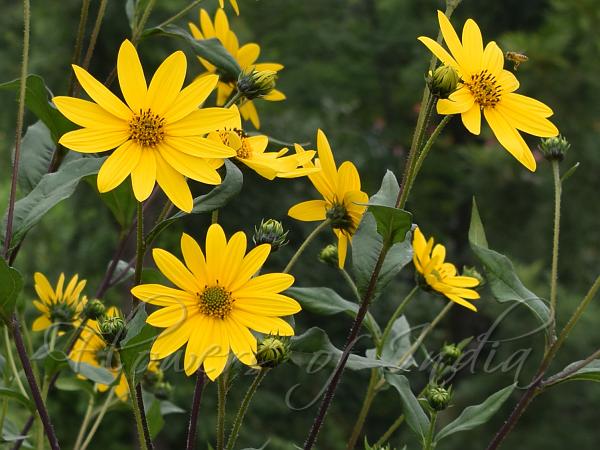|
| Jerusalem Artichoke |
|

|

| File size | 406084 |
| Original date | 8/10/20 3:02 PM |
| Resolution | 4496 x 3000 |
| Flash | Flash did not fire, auto |
| Focal length | 42.0mm |
| Exposure time | 1/160s |
| Aperture | 7.1 |
| Focus Distance | |
| Metering Mode | Center weighted average |
| Camera make | NIKON CORPORATION |
| Camera model | NIKON D5600 |
| Sensor type | OneChipColorArea |
|
|
|
|
Photo: |
Botanical name: Helianthus tuberosus Family: Asteraceae (Sunflower family)
Synonyms: Helianthus tomentosus, Helianthus pubescens
Synonyms: Helianthus tomentosus, Helianthus pubescens
Jerusalem Artichoke is an erect, rhizome-forming
perennial herb, up to 3-4 m tall. Flower heads are 5-11 cm in diameter,
much smaller than that of the sunflower. Each flower has 12 to 20
showy, petal-like, bright sterile yellow rays surrounding many small
yellow tubular fertile florets. It is perennial, but usually grown as
an annual. It is a highly variable plant: many characteristics,
including size, 2-4 m, tuber color, green or violet, stem number and
the number of branches per stem are variable. The stems are generally
hairy and branch in their lower part. The root system is fibrous and
develops cord-like rhizomes that can reach more than 1 m in length. The
tip part of the rhizome is swollen and forms a fleshy tuber. Leaves are
opposite or alternate, ovate to lanceshaped, toothed, velvet-hairy on
the lower surface and 3-20 cm long x 5-8 cm broad. The fruit is a hairy
achene containing a mottled black or brown seed, 5 mm long x 2 mm wide.
Jerusalem artichoke is mainly grown for its edible tubers, which vary
in size and shape. Some are potato-like, small, round and knobby, while
others are long, slender and smooth. Jerusalem artichoke tubers and
aerial parts have long been used to feed cattle, sheep and pigs.
Jerusalem Artichoke is native to North America, cultivated in India and
elsewhere.
| Identification credit: Anil Thakur | Photographed in cultivation in Solan District H.P. |
• Is this flower misidentified? If yes,